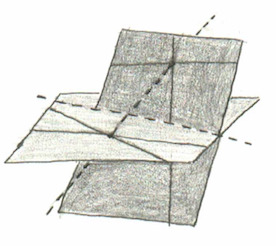#doing all this time trying to give him the tools to solve math & geometry problems 😩🤡
Explore tagged Tumblr posts
Text
The Schubert Problem
This is the first in a little two-part sequence about the history of the Schubert calculus. I like this story a lot because it highlights the really human aspect of doing math, and gives lie to the myth that good mathematics only comes from rigorous logical reasoning. Both of these posts are intended to be roughly independent and nontechnical (with the second one, admittedly, a bit more detail-oriented than the first).
-------
If you study some of the more geometric aspects of math, you at some point start to encounter a lot of objects having the name ‘Schubert’ attached to them: Schubert varieties, Schubert classes, Schubert polynomials. So who was Schubert, anyway?
Hermann Schubert was a German mathematician who worked in the mid-to-late 1800s. Note that he is not Franz Schubert, the famous Classical composer; instead he was a high-school teacher. Although not a member of the university system, he was an active researcher, working in a particularly combinatorial corner of algebraic geometry.
The trouble started when Schubert was trying to answer questions like the following:
Fix four lines in three-dimensional space, no two of which are parallel or intersecting. How many lines intersect all four of them?
If you’re anything like me, you say: there’s no way that’s enough information to give an answer, or even if it is, there’s no way the answer is anything interesting. But in fact, a miracle occurs. Not only is there an answer, but the answer is always the same: there are exactly two such lines!
Schubert was part of a group of people who were interested in answering these questions, and he figured out a brilliant way to do it. You could presumably figure this out by some very long and arduous computations with coordinates, but that’s not what Schubert did. For instance, this is how Schubert solved the problem above:

Let’s solve an easier problem: suppose that there are two pairs of intersecting lines in three-dimensional space, no two of which are parallel. Now, there is one obvious line that meets all four of the others: passing between the two points of intersection. A second line can be constructed as follows: each pair of intersecting lines spans a plane, so take the two planes defined by each pair, and they intersect in a line: that line meets all four of the others.
Now, pick one of the pairs of lines, and pull them apart (slowly?). By continuity considerations, there will still be two lines that intersect all four of them. And then do the same for the other pair and of course there will still be two lines that intersect all four, by conservation of number.
The first time you see this, you may not find this argument very convincing.
Well, turns out nobody else did either.
They said “now, wait just a second here, Schubes. What are these continuity considerations you’re talking about? What’s this whole conservation of number thing?” And Schubert was like “I dunno.”. And the math community said “What do you mean, you don’t know? You don’t have a proof?”. And he was like “Nah man, I don’t have a proof. I have the answer. Deal with it.”.
And they did deal with it. They had to, because he kept solving problems and he kept using these totally wonky methods and he kept getting the right answers. The thing that makes this story really weird is: lots of other people tried to get on this bandwagon, and tons of other people just couldn’t do it. They would do this whole simplifying assumption and try to do this whole “conservation of number” thing and they would just get completely wrong answers.
Eventually, the situation got so ridiculous that in 1900, David Hilbert wrote this as the 15th problem on his famous list:
The problem consists in this: To establish rigorously and with an exact determination of the limits of their validity those geometrical numbers which Schubert especially has determined on the basis of the so-called principle of special position, or conservation of number, by means of the enumerative calculus developed by him.
You can practically feel the frustration seeping out of these words, 117 years later.
Wikipedia lists this question as “partially resolved”. What is meant by this is, to this day, we still don’t really know what “conservation of number” actually means. Phrasing it in Hilbert’s language, we don’t understand the “limits of its validity”. However, in the end, people did figure out a way to do these computations rigorously, and so research interest in figuring out exactly where “number is conserved” has by and large died out.
I’ve already written a little bit about the technical tools which make this possible, but in the next post I’d like to talk about a high-level picture, and an “intermediate step” that I’d never really understood before.
[ Next ]
#math#maths#mathematics#mathema#history#math history#geometry#algebraic geometry#combinatorial geometry#schubert stuff
76 notes
·
View notes